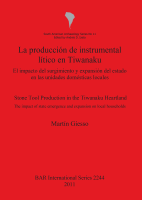Description
BOOK DESCRIPTIONThis research explores the characteristics of stone tool production in the heart of the Andean state of Tiwanaku, comparing tool production on urban and rural settlements and at elite and non-elite sites. Models of the Tiwanaku state are tested, and comparisons with the contemporaneous Wari state are explored. No evidence of craft specialization was recovered from urban or rural sites. The author demonstrates that there was an overall continuity in lithic production from the Formative (1500 B.C. - 400 A.D.) to Middle Horizon (400-1100 A.D.), but significant changes occured after 600 A.D., as exotic raw materials began to be exploited. The state controlled the procurement and distribution of obsidian and black basalt, giving preference to urban dwellers, following the experiences of earlier altiplano polities (the Pukara, Chiripa and Wankarani). At the same time, local groups procured smaller quantities of exotics from other (non-state controlled) sources. Projectile points were locally manufactured and were used in inter-group conflicts.











